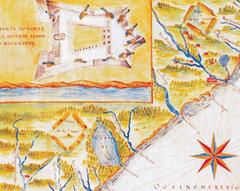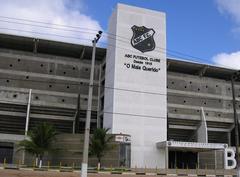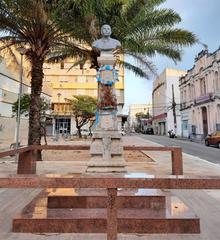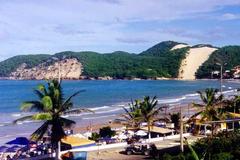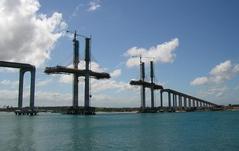Comprehensive Guide to Visiting Natal, Rio Grande do Norte, Brazil
Date: 29/07/2024
Welcome to Natal
Welcome to Natal, the sun-drenched capital of Rio Grande do Norte, Brazil—a city where history and modernity blend seamlessly against a backdrop of golden sands and azure waters. Founded on Christmas Day in 1599, Natal, whose name means ‘Christmas’ in Portuguese, is a living tapestry of stories, cultures, and natural wonders. Imagine a place where colonial forts echo tales of Portuguese and Dutch skirmishes, where stunning beaches invite you to relax or embark on thrilling dune buggy rides, and where vibrant festivals like Carnatal fill the air with music and joy (World Guides) (Scratch Your Mapa) (Brazil City Guides)!
As you stroll through Natal’s historic neighborhoods, you’ll feel the pulse of a city that was once a strategic Allied base during World War II. Picture American soldiers mingling with locals, exchanging cultures, and creating memories that still linger in the atmosphere. From the bustling lower city (Cidade Baixa) to the serene higher city (Cidade Alta), Natal beckons you to explore its multifaceted charm.
But Natal is not just about its past. Today, it stands as a beacon of progress and innovation, being the first Brazilian state to abolish slavery and electing the country’s first female mayor. Its culture is as vibrant as its history, with traditional forró dances, delectable cuisine like ‘ginga com tapioca,’ and hidden gems waiting to be uncovered. Whether you’re visiting the iconic Forte dos Reis Magos, lounging on Ponta Negra Beach, or diving into the local lingo with phrases like ‘Oi, tudo bem?’ (Hi, how are you?), Natal offers an experience that is both enriching and exhilarating.
So, are you ready to dive into the heart of Natal? Let’s embark on this journey through time, culture, and nature, and uncover the secrets of this enchanting city. Your adventure in Natal begins now!
Discover Natal: A Journey Through Time in Rio Grande do Norte, Brazil
Welcome to the Heart of Christmas!
Picture this: a city founded on Christmas Day, brimming with history and bursting with life. Welcome to Natal, the capital of Rio Grande do Norte, where past and present dance in a tropical rhythm. Founded on December 25, 1599, Natal—meaning ‘Nativity’—is a destination that promises both historical intrigue and modern marvels. Ready to dive in? Let’s uncover the secrets of this enchanting city!
Early Settlement and Foundation: A Yuletide Beginning
Our story begins on a Christmas morning in 1599. The Portuguese decided to gift themselves a city, and thus Natal was born. But what’s a city without protection? Enter the Forte dos Reis Magos (Fort of the Wise Kings), named to honor the Three Wise Men and constructed starting January 6, 1598. This fort was the sturdy guardian against French pirates who fancied trading with the local Potiguar tribe.
The Portuguese and Dutch Tug-of-War
Natal’s early days were anything but peaceful. Portuguese forces, led by Governor-General Francisco de Sousa, ousted French traders in 1597. Fast forward to 1633, and the city found itself under Dutch control. The Dutch renamed the fort to Fort Ceulen, leaving their mark until the Portuguese reclaimed it in 1654. Imagine the conversations in those walls—if forts could talk!
Colonial and Economic Development: A Different Path
While sugarcane turned other Brazilian regions into sweet success stories, Natal’s sandy soil had other plans. Cattle raising became the economic anchor here, shaping a unique development narrative. This bovine boom made Natal distinct from its sugar-coated counterparts.
19th Century and Early Modernization: The Two Cities
By the 1800s, Natal was a tale of two cities: the bustling lower city (Cidade Baixa) for commerce and the serene higher city (Cidade Alta) for governance and worship. The 1930s brought urbanization that transformed this quaint village into a burgeoning city, thanks to Pedro Velho’s modernization efforts.
World War II: The American Invasion—But Friendly!
World War II catapulted Natal into global significance. Its strategic location made it a pivotal Allied base, bringing thousands of American soldiers and a cultural exchange that left an indelible mark. Think of it as Natal’s very own ‘Yankee Doodle Dandy’ moment!
Post-War Development: Beach Paradise
Post-war, Natal blossomed into a tourist haven. Picture yourself on pristine beaches with golden dunes, perhaps savoring a fresh papaya or cashew fruit. The economy diversified, with tourism, agriculture, and exports like crustaceans and carnauba wax driving growth.
Cultural and Historical Significance: A Beacon of Progress
Natal isn’t just a pretty face. It’s a trailblazer, being the first Brazilian state to abolish slavery and electing the country’s first female mayor. This progressive spirit is woven into the fabric of the city, making it a beacon of liberty and innovation.
Hidden Gems and Local Secrets
Beyond the well-trodden paths, Natal hides treasures waiting to be discovered. Explore the lesser-known beaches where locals unwind, or join a traditional forró dance to feel the city’s rhythm. Don’t miss the culinary delights—try the ‘ginga com tapioca’ at the bustling Redinha Market.
Architectural and Historical Landmarks
The Forte dos Reis Magos stands as a sentinel of history, guiding you through colonial defenses. Nearby, the 1694 cathedral whispers tales of faith and resilience. Each landmark is a chapter in Natal’s vibrant story.
Time-Based Itineraries: Choose Your Adventure!
Morning: Start at Forte dos Reis Magos, then stroll through Cidade Alta.
Afternoon: Lunch at a local eatery, followed by a visit to the cathedral.
Evening: Unwind at Ponta Negra Beach, watching the sunset over the dunes.
Local Lingo and Fun Facts
Brush up on your Portuguese with phrases like “Oi, tudo bem?” (Hi, how are you?) and “Beleza!” (Cool!). Did you know? Natal’s nickname is “Cidade do Sol” (City of the Sun) because it enjoys over 300 sunny days a year!
Seasonal Highlights: Natal Year-Round
From vibrant Carnival celebrations to tranquil beach days, Natal offers something special in every season. Visit in June for the São João Festival, a riot of dance and color celebrating Saint John.
Significance and Attractions in Natal, Rio Grande do Norte, Brazil
Introduction
Imagine a land where golden sands meet azure waters and history whispers through star-shaped forts. Welcome to Natal, Brazil’s hidden gem, founded on Christmas Day in 1599. Natal isn’t just a city; it’s an experience! Think of it as Brazil’s sun-kissed love letter to beach lovers and history buffs alike.
Historical Significance
Natal, the capital of Rio Grande do Norte, holds a rich historical tapestry that dates back to the Portuguese era. Founded on December 25, 1599, by Portuguese settlers, the city’s name, which means “Christmas” in Portuguese, reflects its founding date. The city’s strategic location made it a focal point during the colonial period, especially during the Dutch invasion in the 17th century. The Dutch occupied Natal from 1633 to 1654, leaving behind architectural influences that can still be seen today (World Guides).
Natural Attractions
Beaches
Natal is renowned for its stunning beaches, which are a major draw for tourists. The city boasts numerous beaches with golden sands, turquoise waters, and lush palm trees. Some of the most popular beaches include:
- Ponta Negra Beach: Known for its vibrant nightlife and the iconic Morro do Careca, a large dune at the southern end of the beach.
- Genipabu Beach: Famous for its towering sand dunes and the option for thrilling buggy rides.
- Tabatinga Beach: A more tranquil option, ideal for those looking to relax and enjoy the natural beauty (Scratch Your Mapa).
Dunes and Lagoons
The dunes of Natal are not just for sightseeing; they offer a range of activities such as sandboarding and dune buggy rides. The Genipabu Dunes are particularly famous and provide a unique landscape that is perfect for adventure seekers. Additionally, the city is home to several beautiful lagoons, such as the Pitangui Lagoon, where visitors can enjoy swimming and other water activities (Brazil City Guides).
Cultural Attractions
Forte dos Reis Magos
One of the most significant historical landmarks in Natal is the Forte dos Reis Magos. This star-shaped fort was built by the Portuguese in 1598 and played a crucial role in the defense against Dutch invasions. Today, it serves as a museum, offering insights into the colonial history of the region (World Guides).
Natal’s Festivities
Given its name, Natal is a fantastic place to visit during the Christmas season. The city is festively decorated, and visitors can enjoy fireworks and parades. Additionally, Natal hosts a vibrant Carnival, which is a must-see for anyone interested in Brazilian culture. Other significant holidays include Independence Day on September 7 and Our Lady of Aparecida Day on October 12 (Scratch Your Mapa).
Visitor Tips
Best Time to Visit
Natal enjoys a tropical climate with more than 300 sunny days a year, making it a year-round destination. However, for those looking to avoid the crowds, visiting just before or after the summer season is ideal. December is particularly special due to the Christmas celebrations (Brazil City Guides).
Accommodation
The choice of neighborhood can significantly impact your experience in Natal. For families, Barreira d’Água is recommended, while Ponta Negra is ideal for individual travelers and groups. Couples might prefer the more secluded Via Costeira (Brazil City Guides).
Currency and Language
The official currency in Natal is the Brazilian Real (R$). While Portuguese is the official language, English is commonly spoken in tourist areas and hotels, making it easier for international visitors to navigate the city (Brazil City Guides).
Unique Experiences
Dune Buggy Rides
One of the most exhilarating activities in Natal is a dune buggy ride. These rides offer a thrilling way to explore the vast sand dunes and often include stops at various lagoons for a refreshing swim. The rides can be tailored to be either adventurous or more relaxed, depending on the preference of the visitors (Scratch Your Mapa).
Wild Horses
A lesser-known but fascinating aspect of Natal is the presence of wild horses. These horses can often be seen roaming freely in certain areas, adding a unique touch to the natural beauty of the region (Scratch Your Mapa).
Practical Information
Airport
The main airport serving Natal is the Natal International Airport – São Gonçalo do Amarante (NAT). It is well-connected to major cities in Brazil and offers various amenities to ensure a comfortable travel experience (Brazil City Guides).
Safety Tips
While Natal is generally safe for tourists, it is always advisable to take standard precautions. Avoid carrying large amounts of cash, be cautious in less crowded areas, and always keep an eye on your belongings. Staying in well-reviewed accommodations and using reputable tour operators can also enhance your safety (Brazil City Guides).
Cultural Insights: A Journey Through Natal
Captivating Introduction
Welcome to Natal, the dazzling jewel of Brazil’s northeastern coast! Picture this: a city where history whispers through ancient fortresses, festivals explode with color and rhythm, and the aroma of fresh seafood wafts through the air. Founded on Christmas Day in 1599, Natal’s name literally means “Christmas” in Portuguese. Ready to unwrap the gift that is Natal?
Historical Significance
Let’s travel back in time to 1598, when the majestic Fortaleza dos Reis Magos sprang to life. This fortress, a stalwart guardian against Dutch invasions, stands proudly on Praia do Forte. Imagine standing on its ramparts, feeling the Atlantic breeze and hearing the echoes of colonial battles. History buffs, this is your paradise!
Local Traditions and Festivals
Natal knows how to throw a party! Ever heard of the Carnatal? It’s Brazil’s largest off-season carnival, a December extravaganza of parades, music, and dance. Picture yourself dancing to the infectious beats of axé and frevo, surrounded by locals and visitors swept up in the festive spirit.
But the fun doesn’t stop there. January brings the Festa de Santos Reis, or Festival of the Three Kings. This religious celebration features processions, masses, and traditional dances, a heartwarming reflection of Natal’s Catholic roots.
Cuisine and Dining
Your taste buds are in for a treat! Natal’s culinary delights are a testament to its coastal bounty. Savor a bowl of moqueca, a sumptuous fish stew infused with coconut milk, tomatoes, onions, and cilantro. Or try carne de sol, sun-dried beef served with cassava and beans.
For a dining experience with a view, head to Ponta Negra. Imagine enjoying fresh seafood as the sun sets over the Atlantic, the casual atmosphere inviting you to relax and unwind. T-shirts, shorts, and thong sandals are welcome here—feel the freedom!
Arts and Handicrafts
Natal’s artistic soul thrives at the Centro de Turismo de Natal. This former orphanage and prison now bursts with local artisan-made handicrafts, from delicate lacework to intricate wood carvings. Wander through the shops, pick up unique souvenirs, and maybe even catch a live performance or workshop.
The historic center is another cultural treasure trove, where beautifully preserved buildings house museums and cultural centers. Step inside and discover the stories behind Natal’s artistic heritage.
Music and Dance
Music and dance pulse through Natal’s veins. Forró, a lively Brazilian music genre, beckons you to dance with its upbeat rhythms. Local clubs and bars regularly host live bands, offering you a chance to experience this joyful tradition firsthand.
During Carnatal, axé music takes center stage, its Afro-Caribbean rhythms blending seamlessly with Brazilian beats. The streets come alive with parades and parties, creating an unforgettable musical tapestry.
Language and Communication
While Portuguese is the official language, don’t worry if you’re not fluent. Many locals speak some English, especially in tourist areas. But why not sprinkle in a few Portuguese phrases? A cheerful “bom dia” (good morning) or a heartfelt “obrigado” (thank you) can go a long way in connecting with the friendly residents.
Dress Code and Etiquette
Embrace Natal’s laid-back vibe with casual attire—T-shirts, shorts, and thong sandals are the norm. However, when visiting religious sites or attending formal events, opt for more conservative clothing.
Greeting customs are warm and inviting, often involving a handshake or a kiss on the cheek. And don’t stress about punctuality—social events here often start later than scheduled.
Safety and Health
Natal is generally safe, but it’s wise to stay cautious. Avoid walking alone at night in unfamiliar areas and keep an eye on your belongings in crowded places. For transportation, stick to reputable taxi services or ride-sharing apps.
Enjoying Natal’s sunny climate? Don’t forget your sunscreen, hat, and water. With temperatures averaging between 25°C and 30°C (77°F to 86°F), the sun can be intense. And breathe easy—Natal boasts some of the cleanest air in the Americas.
Local Secrets and Hidden Gems
Shhh, want to know a secret? Head to the hidden gem of Genipabu Beach, where you can ride a camel or explore towering sand dunes. Or visit the enchanting Parrachos de Maracajaú, a natural aquarium teeming with marine life.
Interactive Elements
Ready for a challenge? Try finding the best caipirinha in town! Or embark on a mini-quest to discover the most stunning sunset view. Each discovery adds a new layer to your Natal adventure.
Pop Culture References
Did you know? Natal has been featured in several Brazilian films and TV shows, adding cinematic flair to its charm. See if you can spot familiar scenes during your visit!
Time-Based Itineraries
Create your own adventure! Spend a day exploring historic sites, followed by an evening of forró dancing. Or dedicate a weekend to beach hopping and savoring local cuisine. The choice is yours!
Local Lingo Lessons
Learn some local slang and impress the natives. Try saying “e aí” (what’s up) or “massa” (cool). Practice your pronunciation and watch the smiles appear.
Seasonal Highlights
Natal transforms with the seasons. From the vibrant festivities of Carnatal in December to the serene beauty of the beaches in January, there’s always something unique to experience. Each season paints the city in new, captivating colors.
Myth Busting and Surprises
Think you know Natal? Think again! Despite common misconceptions, Natal is more than just a beach destination. Its cultural depth and historical richness will surprise you at every turn.
Storytelling Elements
Imagine the tales told by the old fishermen at Ponta Negra, or the legends whispered within the walls of Fortaleza dos Reis Magos. Natal’s history is a tapestry of stories waiting to be discovered.
FAQ
Got questions? We’ve got answers! From the best time to visit to must-try dishes, our FAQ section covers all your curiosities.
Call to Action
Ready to explore Natal like a true local? Download Audiala, your ultimate tour guide app. With expert insights and hidden gems at your fingertips, you’re all set for an unforgettable adventure. Dive into Natal’s vibrant culture and let the journey begin!
Your Invitation to Explore withAudiala
As we conclude our journey through Natal, Rio Grande do Norte, it’s clear that this city is much more than a picturesque beach destination. Natal is a vibrant tapestry of history, culture, and natural beauty, offering something for every type of traveler. From its colonial past, marked by the construction of the Forte dos Reis Magos in 1598, to its role as a strategic Allied base during World War II, the city’s historical significance is palpable (World Guides).
Natal’s stunning beaches, such as Ponta Negra and Genipabu, are not just for sunbathing; they’re gateways to thrilling adventures like dune buggy rides and sandboarding. The city’s unique economic history, shaped by cattle raising rather than sugarcane, adds another layer to its distinctive character. And let’s not forget the cultural richness—whether it’s participating in the vibrant Carnatal festival or savoring local delicacies like moqueca and carne de sol, Natal offers a sensory feast for visitors (Scratch Your Mapa) (Brazil City Guides).
What truly sets Natal apart is its spirit of progress and innovation. This is a city that has consistently broken barriers, from being the first Brazilian state to abolish slavery to electing the country’s first female mayor. Such milestones are woven into the very fabric of Natal, making it a beacon of liberty and forward-thinking ideals.
So, whether you’re exploring hidden gems like Genipabu Beach, engaging in local traditions, or simply soaking in the breathtaking landscapes, Natal promises an unforgettable experience. And remember, to truly unlock all the secrets and stories of this captivating city, download Audiala, your ultimate travel companion. With expert insights and hidden gems at your fingertips, your Natal adventure will be as enriching as it is exhilarating. Dive into Natal’s vibrant culture and let the journey begin!
Sources and Further Reading
- World Guides. (n.d.). Natal History. http://www.world-guides.com/latin-america/brazil/rio-grande-do-norte/natal/natal_history.html
- Scratch Your Mapa. (n.d.). A Complete Travel Guide for Visiting Natal in Brazil. https://scratchyourmapa.com/a-complete-travel-guide-for-visiting-natal-in-brazil/
- Brazil City Guides. (n.d.). Natal Travel Guide. https://brazilcityguides.com/natal-travel-guide














